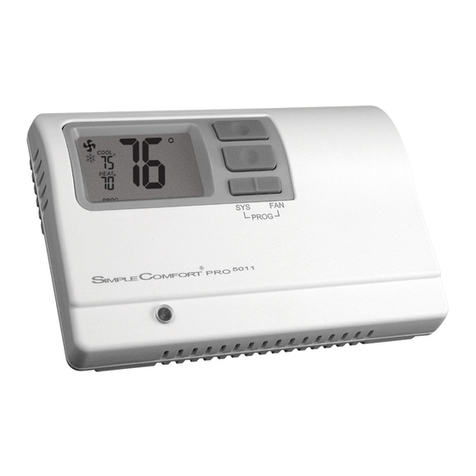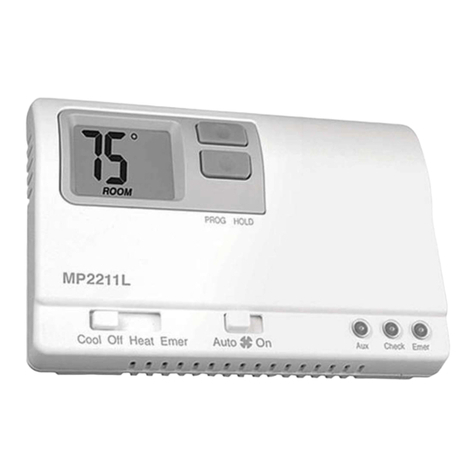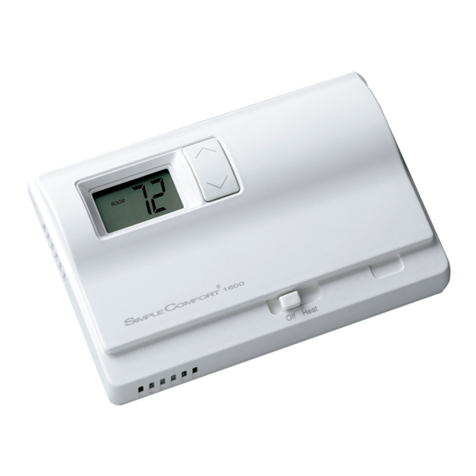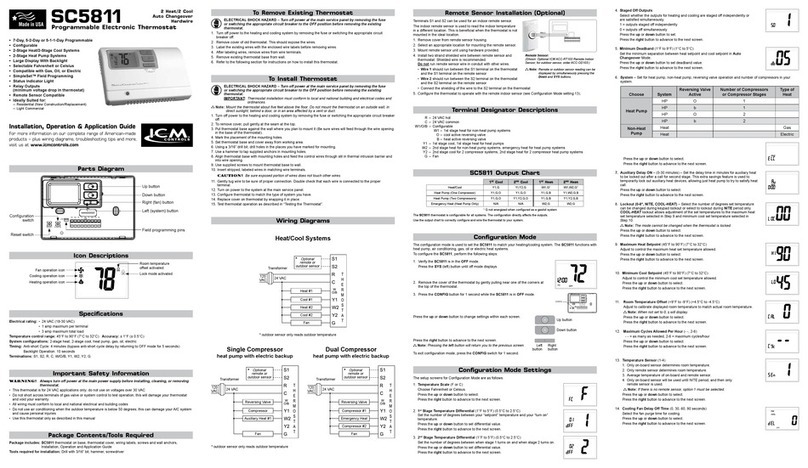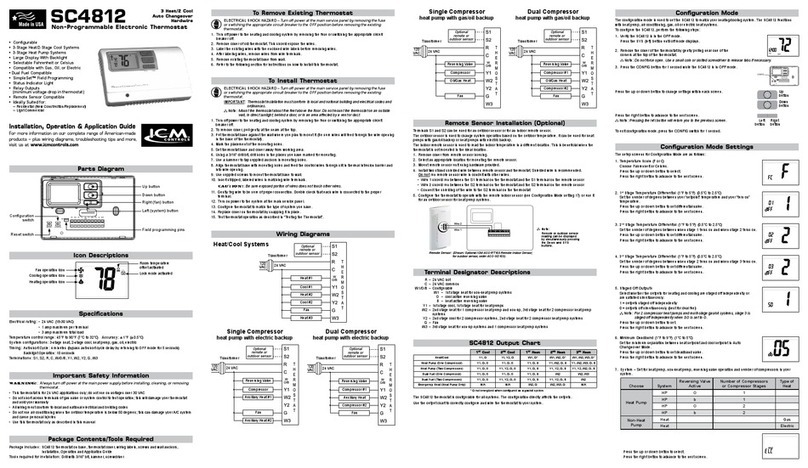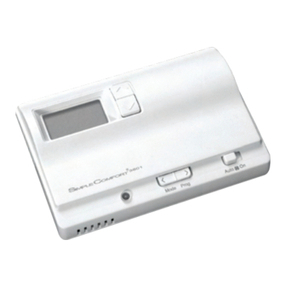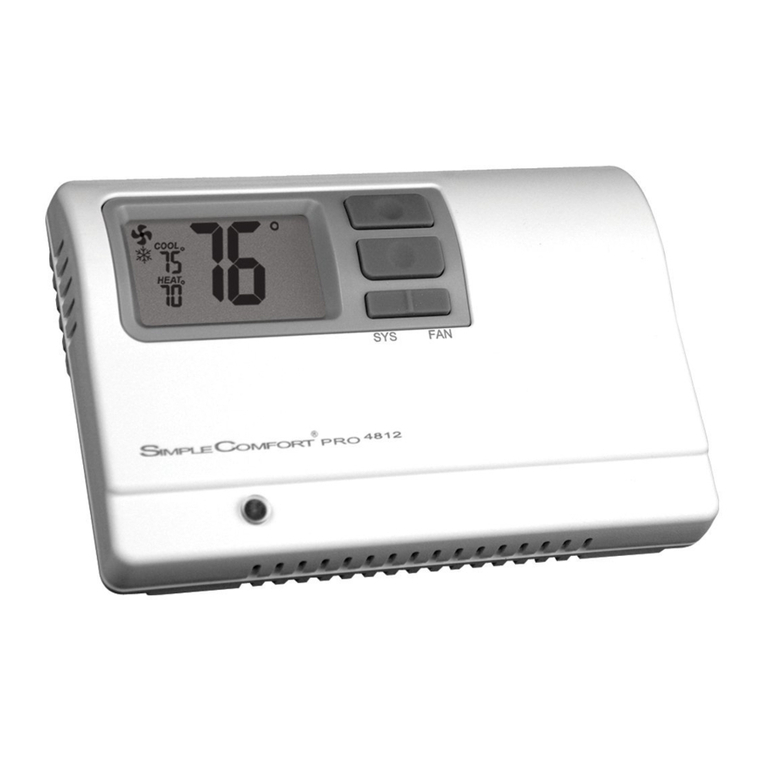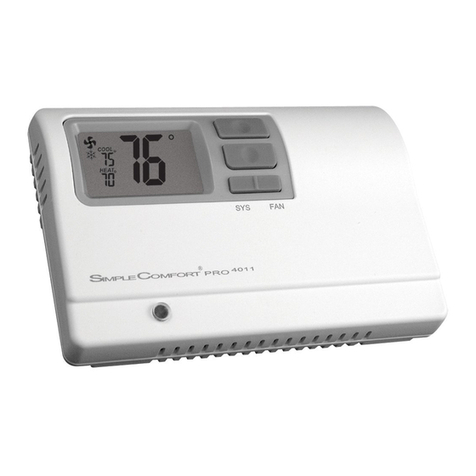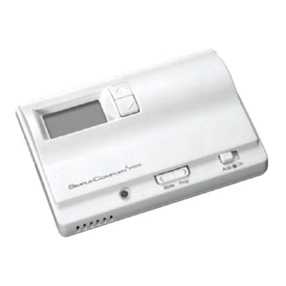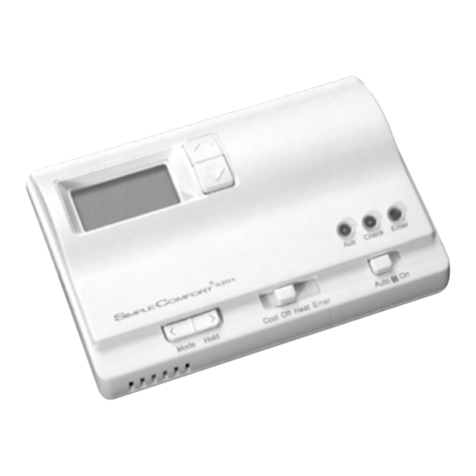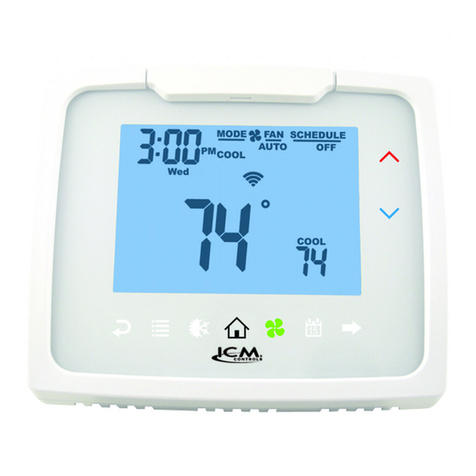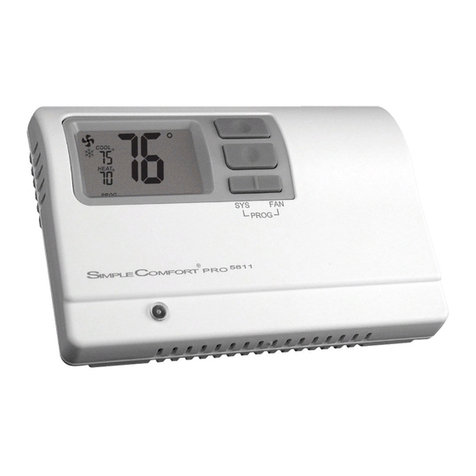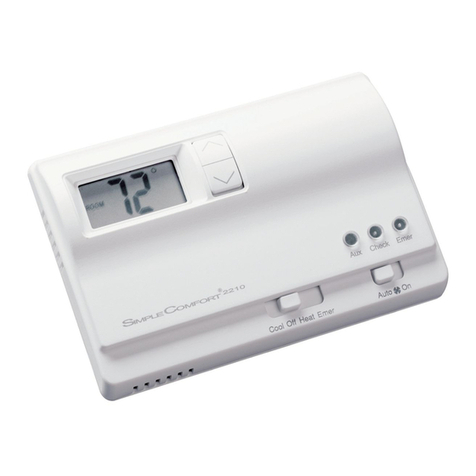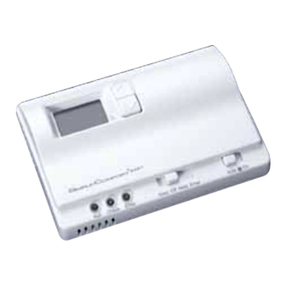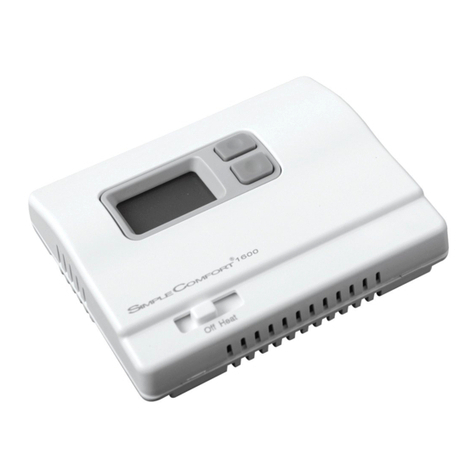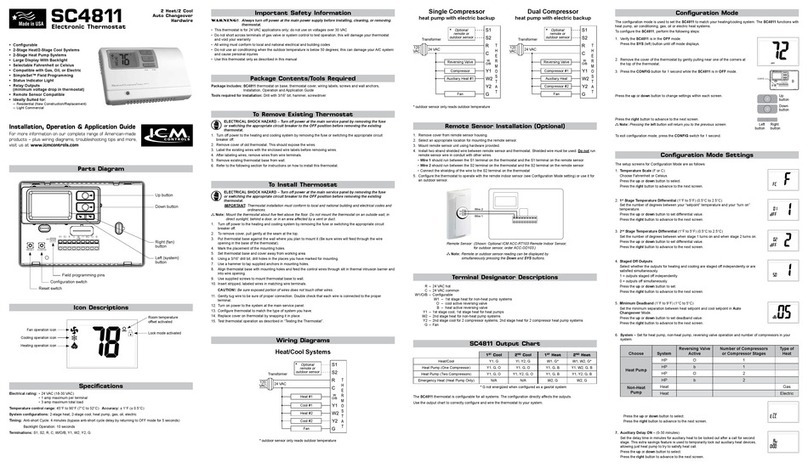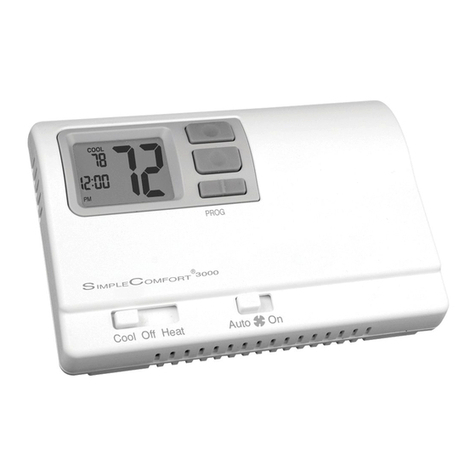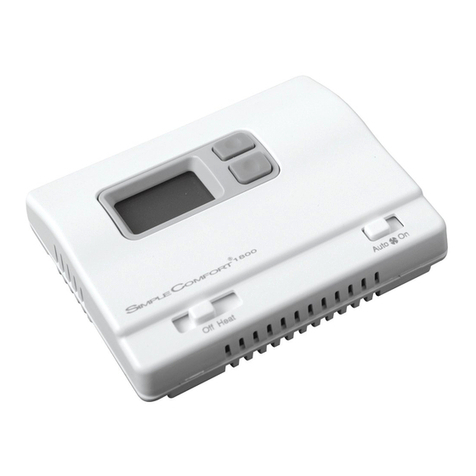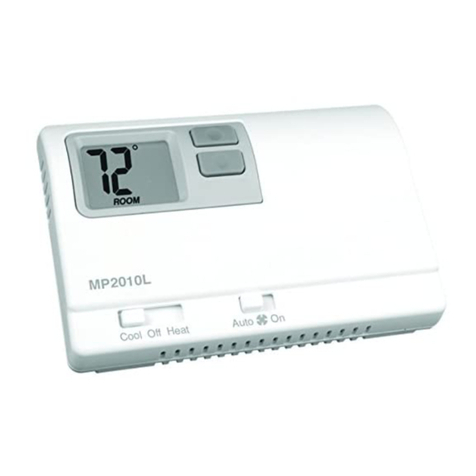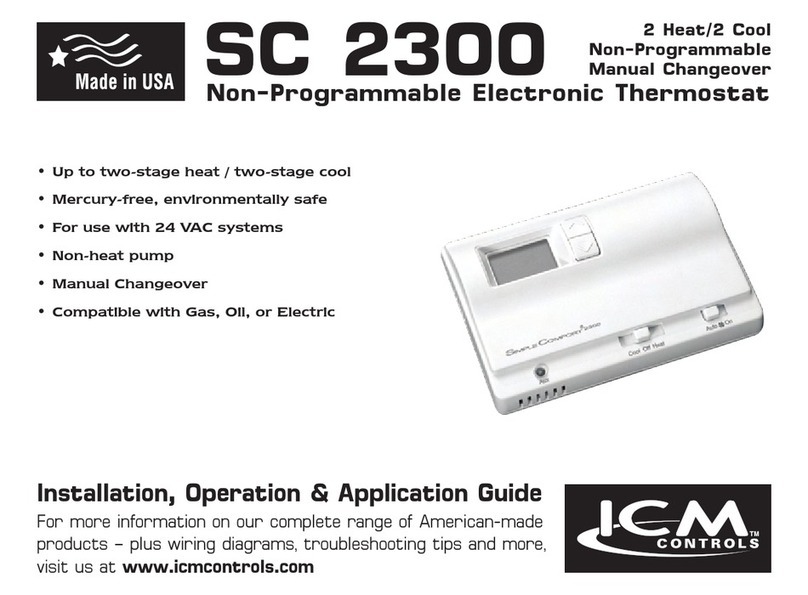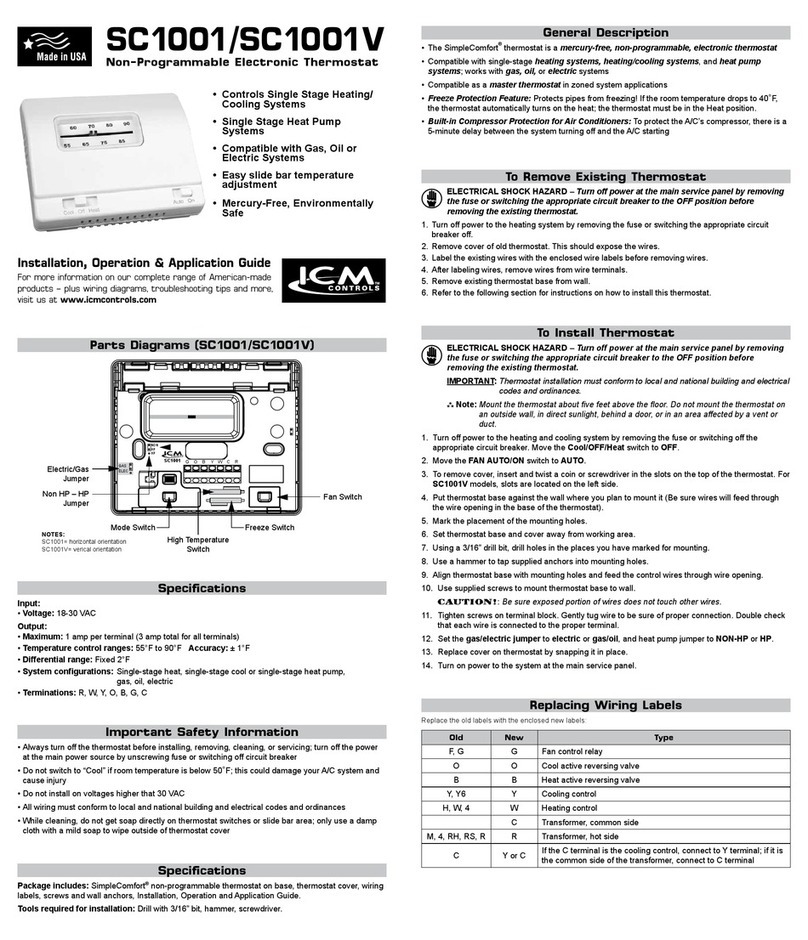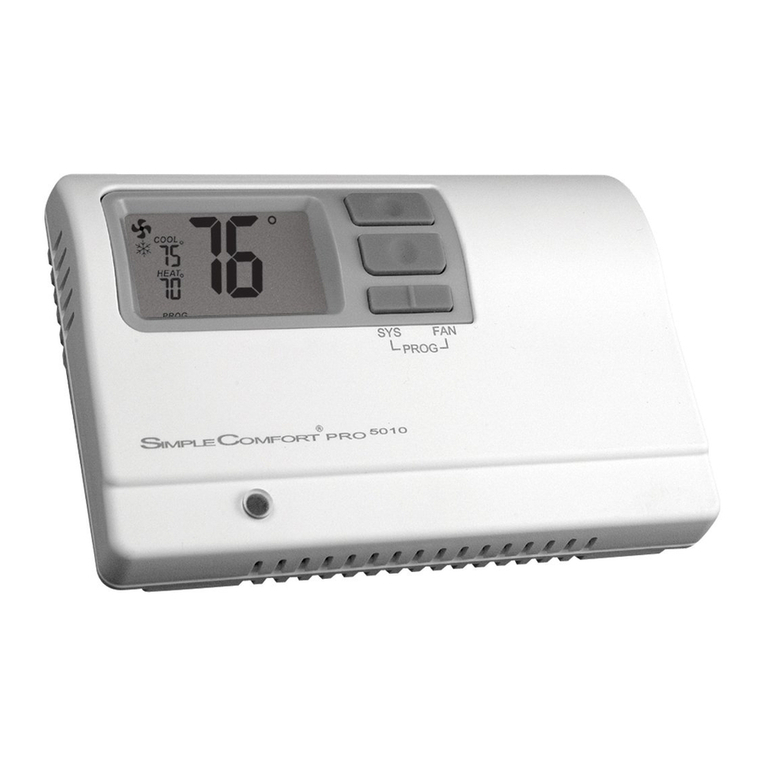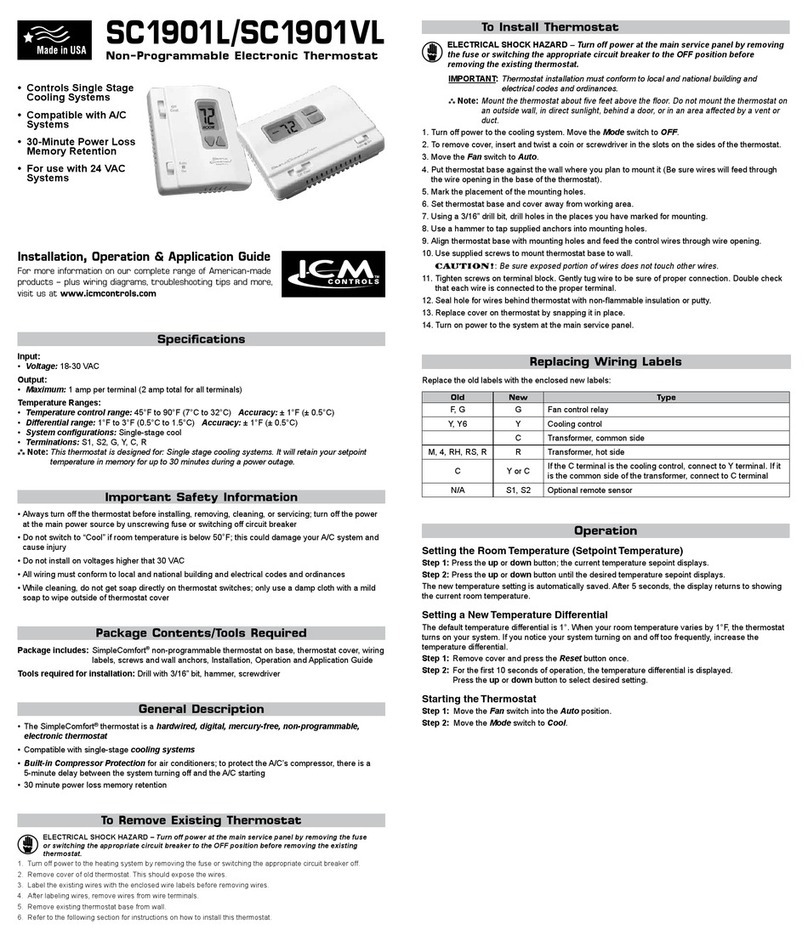Symptom Remedy
No display Check for 24 VAC at thermostat; display is blank when 24 VAC is
not present or if batteries are completely discharged.
System fan does not come
on properly
Verify wiring is correct, check Gas/Electric Conguration
(see Setting 4).
No response with rst button
press
First button press activates backlight only (when back light is
congured “ON”).
Thermostat turns on and off
too frequently
Adjust temperature differential
(see Conguration Mode Setting 2).
Fan runs continuously Press FAN (right) button to turn fan off.
Status indicator light not on
during call
Turn status indicator function on
(see Conguration Mode Setting 12).
Room temperature is not
correct
Calibrate thermostat (see Conguration Mode Setting 8). If remote
sensor is used, check S1 and S2 terminal connections. Press SYS
and down to display outdoor temperature
displays when any button
is pressed
Thermostat has the button lockout function activated
(see Lockout Feature and Conguration Mode Setting 5).
on display instead of
room temperature
Check for a bad connection at S1 and S2 terminals, if used
(see Conguration Mode Setting 10).
Heat or Cool not coming on Verify wiring is correct, verify RC/RH jumper is in place (for single
transformer system).
Remote or outdoor sensor
not accurate
Press SYS and down buttons simultaneously to display remote or
outdoor temperature.
Verify connections at S1 and S2 terminals.
LOBATon display Replace batteries with two fresh “AAA” batteries. LOBAT may
display if no batteries are installed and there is a loss of power.
Problem not listed above Press Reset button once*.
*ResetButtonFunction: Display is refreshed and conguration settings are unchanged.
7. MinimumCoolSetpoint (45°F to 90°F) (7°C to 32°C)
Adjust to control the minimum cool set temperature allowed.
Press the up or down button to select.
Press the right button to advance to the next screen.
8. RoomTemperatureOffset (+9°F to -9°F) (+4.5°C to -4.5°C)
Adjust to calibrate displayed room temperature to match actual room
temperature.
Note: When not set to 0, will display
Press the up or down button to select.
Press the right button to advance to the next screen.
9. MaximumCyclesAllowedPerHour (- -, 2-6)
- - = as many as needed, 2-6 = maximum cycles/hour
Press the up or down button to select.
Press the right button to advance to the next screen.
12. StatusIndicatorLight (0 or 1)
0 = Status indicator never on (best for long battery life)
1 = Status indicator on with rst stage
Press the up or down button to select.
Press the right button to advance to the next screen.
OFF
11. CoolingFanDelayOffTime (0, 30, 60, 90 seconds)
Select the fan purge time for cooling.
Press the up or down button to select.
Press the right button to advance to the next screen.
10. TemperatureSensor (1-3)
1. Only on-board sensor determines room temperature.
2. Only remote sensor determines room temperature.
3. Average temperature of on-board and remote sensor.
Press the up or down button to select.
Press the right button to advance to the next screen.
13. BackLight (0 or 1)
0 = Back light never on (best for long battery life)
1 = Back light on when button pressed
Press the up or down button to select.
Press the CONFIG button for 2 seconds to exit conguration.
Mode of Operation
The SC4010 is a non-programmable, manual or auto changeover, single stage heat, single stage cool
thermostat. It functions with air conditioning, heat pumps, gas, oil or electric heat systems.
The thermostat activates the heating appliance when the room temperature is below the set heat
temperature (by the differential temperature) and the red indicator light (congurable) on the
thermostat will light. The SC4010 will stop outputting and the red light will turn off when the call for
heat has been satised. With heat pumps, the thermostat will not let the compressor come on for 4
minutes after it turns off. This protects your compressor.
When the room temperature is greater than the set cool temperature (by the differential temperature),
the cooling device is activated and the green indicator light (congurable) on the thermostat will
turn on. The SC4010 will stop outputting and the green light will turn off when the call for cooling
is satised. The thermostat will not let the compressor come on for 4 minutes after it turns off. This
protects your compressor.
The SC4010 has four possible operating modes: OFF, Heat, Cool, and Heat&Cool mode. In off
mode, the thermostat will not turn on heating or cooling devices. The manual fan can be turned on in
all operating modes using the fan button. In heat mode, the thermostat controls the heating system.
In the cool mode, the thermostat controls the cooling system. In heat & cool mode, the thermostat
controls both the heating and cooling systems.
The SC4010 also has a button lockout feature. This enables the thermostat to be set to the proper
mode and temperature and locked so it cannot be tampered with.
Operating Modes
There are four possible operating modes for the SC4010. Off, Cool, Heat, and Cool & Heat modes
are accessed by pressing the SYS (left) button.
Heat Mode
• Inthismode,thethermostatcontrolstheheatingsystem.Whentheheat
outputs,theameicon apprearsonthedisplay.
Note: For heat pumps, there is a four minute delay for your compressor
to restart after it has turned off.
Cool Mode
• Inthismode,thethermostatcontrolsthecoolingsystem.Whenthecooling
outputs,thesnowakeicon apprearsonthedisplay.
Note: There is a four minute delay for your compressor to restart after it
has turned off.
Cool and Heat Mode(AutoChangeover)
• Inthismode,thethermostatcontrolsthecoolingandheatingsystems,
automaticallychangingoverfromonetotheotherasneeded.
OFF Mode
• Inthismode,thethermostatwill not turn on the heating or cooling devices
Note: The indoor fan can be turned on manually in every operating mode
by pressing the FAN (right) button. The word FAN shows on the
display and the fan icon appears when the fan operates.
Testing the Thermostat
Once the thermostat is congured, it should be thoroughly tested.
CAUTION!
:
Do not energize the air conditioning system when the outdoor temperature is
below 50 degrees. It can result in equipment damage or personal injury.
Heat Test
1. Press SYS (left) button until heat mode is displayed.
2. Adjust the set temperature so it is 5 degrees above the room temperature.
3. Heat should come on within a few seconds. Red LED may turn on.
4. Adjust the set temperature 2 degrees below the room temperature and
the heat should turn off. There may be a fan delay on your system.
Note:
For heat pumps, there is a four-minute delay to protect your compressor after it turns off.
To bypass the compressor time delay, go to OFF mode for 5 seconds
PM
Cool Test
1. Press SYS (left) button until cool mode is displayed.
2. Adjust set temperature so it is 5 degrees below room temperature.
3. A/C should come on within a few seconds. Green LED may turn ON.
4. Adjust the set temperature 2 degrees above the room temperature and the
A/C should turn off. There may be a fan delay on your system.
Note:
There is a four-minute time delay to protect the compressor after it
turns off.
To bypass the compressor time delay, go to OFF mode for 5 seconds.
PM
Fan Test
1. Press FAN (right) button. Fan displays. Indoor fan turns ON.
2. Press FAN (right) button. Indoor fan turns OFF.
PM
OFF
Lockout Feature
The SC4010 has a button lockout feature so the mode cannot be changed
and the temperature adjustment is limited. Select the appropriate lockout
from Conguration Mode Settings (Step 5) of this guide.
To activate the LOCK feature:
1. Simultaneously press the SYS, FAN and UP buttons for 10 seconds.
2. will display and the lockout function will be enabled.
To deactivate the LOCK feature, repeat steps 1 and 2 above.
SimpleSetTM Field Programming
This feature is used for transferring the conguration from the master to the target thermostat. All
thermostats for a job can be mounted and powered up. Congure one thermostat. This will be the
master. The master will be used to copy conguration to the rest of the thermostats.
PreparingthemastertoSend:
1. The master must be powered with 24 VAC or batteries.
2. Verify the master thermostat is in OFF mode.
3. Press SYS (left) button until OFF mode displays.
4. Remove cover of the master thermostat by gently pulling near one of the corners
at the top of the thermostat.
5. Press the up and down buttons and CONFIG switch simultaneously for 5
seconds.
6. The OUT screen displays indicating the master thermostat is ready to
transfer data.
Note: Press the up and down buttons and CONFIG switch simultaneously
for 5 seconds to exit from data transfer mode and to return the master
to the OFF mode.
7. Turn off power to the master and remove it from the wall.
8. Connect the master to the target using the 3 wire connector. Attach
one end to the Master’s FP pins and the other end to the Target’s FP pins.
Note:Target thermostat must be powered with 24 VAC or batteries
for eld programming to occur.
When the connection has been made correctly, the master thermostat will power up and the target will
count from 5 down to 1. It will then display the LOCK conrming the data has been saved in memory.
When all target thermostats have been completed, reinstall the master thermostat.
Press the up and down buttons and the CONFIG switch simultaneously for 5 seconds to exit from
the data transfer mode and to return the master thermostat to the OFF mode.
OFF
FP pins
S1 S2 Y W
O/B G RC RH C
RESET CONFIG
RC
RH
FP
Troubleshooting
LIAF036
Patent No. - Design: 424,953
Patent No. - Thermal Intrusion Barrier: 6,597,275
Patent Pending - SimpleSet
TM
Target Programming Technology
7313 William Barry Blvd., North Syracuse, NY 13212
(Toll Free)800-365-5525(Phone)315-233-5266(Fax)315-233-5276
www.icmcontrols.com
5. Lockout(0-8°,COOL-HEAT)– Select the number of degrees set
temperature can be changed during keypad lockout. COOL-HEAT lockout
allows adjustment of the set temperatures to the maximum heat set
temperature selected in Step 6 and minimum cool set temperature selected
in Step 7.
Note: The mode cannot be changed when the thermostat is locked.
Press the up or down button to select.
Press the right button to advance to the next screen.
6. MaximumHeatSetpoint (45°F to 90°F) (7°C to 32°C)
Adjust to control the maximum heat set temperature allowed.
Press the up or down button to select.
Press the right button to advance to the next screen.
FIVE-YEAR LIMITED WARRANTY
The Seller warrants its products against defects in material or workmanship for a period of ve (5) years from the
date of manufacture. The liability of the Seller is limited, at its option, to repair, replace or issue a non-case credit for
the purchase prices of the goods which are provided to be defective. The warranty and remedies set forth herein
do not apply to any goods or parts thereof which have been subjected to misuse including any use or application
in violation of the Seller’s instructions, neglect, tampering, improper storage, incorrect installation or servicing not
performed by the Seller. In order to permit the Seller to properly administer the warranty, the Buyer shall: 1) Notify
the Seller promptly of any claim, submitting date code information or any other pertinent data as requested by the
Seller. 2) Permit the Seller to inspect and test the product claimed to be defective. Items claimed to be defective
and are determined by Seller to be non-defective are subject to a $30.00 per hour inspection fee. This warranty
constitutes the Seller’s sole liability hereunder and is in lieu of any other warranty expressed, implied or statutory.
Unless otherwise stated in writing, Seller makes no warranty that the goods depicted or described herein are t for
any particular purpose.
